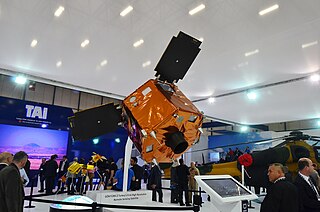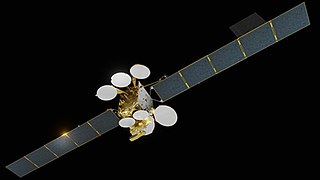Related Research Articles
Türksat Satellite Communications Cable TV and Operations Incorporated is the sole communications satellite operator in Turkey. It was established on 21 December 1990 as a state-owned company named Türksat Milli Haberleşme Uyduları in Gölbaşı, Ankara Province; eventually incorporating the satellite services of Türk Telekomünikasyon A.Ş. and becoming Türksat A.Ş. on 22 July 2004. Türksat A.Ş. also owns 100% of the shares of Eurasiasat S.A.M., jointly established as a spin-off company with Aérospatiale in 1996 to manufacture and launch Türksat 2A in 2001.
Türksat is the name of a series of Turkish communications satellites operated or projected by the state-owned Türksat A.Ş.

Göktürk-2 is an Earth observation satellite designed and developed by the Scientific and Technological Research Council of Turkey (TÜBİTAK) and built by TÜBİTAK Space Technologies Research Institute and Turkish Aerospace Industries (TUSAŞ) for the Turkish Ministry of National Defence.
RASAT was an Earth observation satellite designed and developed by TÜBİTAK Space Technologies Research Institute and produced in Turkey to provide high resolution imagery. It was the first remote sensing satellite fully realized in Turkey, and the second indigenously developed remote sensing satellite after BILSAT-1.
Türksat 1A was a Turkish communications satellite as part of a project to form an instant network with two geosynchronous satellites that is supervised by the companies Türksat A.Ş. in Turkey and Aérospatiale of France.
Turksat 1B was a Turkish communications satellite as part of a project to form an instant network with two geosynchronous satellites that is supervised by the companies Türksat A.Ş. in Turkey and Aérospatiale of France.
Türksat 4A is a Turkish communications satellite, operated by Türksat. It was constructed by Mitsubishi Electric (MELCO) of Japan, based on the MELCO DS2000 satellite bus, and was launched by the American-Russian joint-venture company International Launch Services (ILS) atop a Russian Proton-M space launch vehicle on February 14, 2014, at 21:09:03 from Site 81/24 of the Baikonur Cosmodrome in Kazakhstan.

Türksat 4B is a Turkish communications satellite, operated by Türksat.

Türksat 5A, is a Turkish communications satellite, operated by Türksat A.Ş. for commercial and military purposes.

Göktürk-1 is a high resolution Earth observation satellite designed and developed for the Turkish Ministry of National Defence by the Italian space service company Telespazio with technological input from Turkish Aerospace Industries (TUSAŞ) and ASELSAN of Turkey.
TurkSat-3USat is a Turkish communications nanosatellite developed by the Space Systems Design and Test Laboratory and Radio Frequency Electronics Laboratory of Istanbul Technical University (ITU) in collaboration with the Türksat company along with Turkish Amateur Satellite Technology Organization (TAMSAT). It was launched on 26 April 2013.
The Gölbaşı Ground Station is a ground station designed as a terminal for telecommunication with Türksat spacecraft. Owned and operated by the state-owned telecommunications provider Türksat company, it is situated in Gölbaşı district of Ankara Province in Turkey.
Türksat 6A is Turkey's first fully domestically produced communications satellite, successfully launched on July 8, 2024
Professor Yucel Altunbasak was born in Kayseri, Turkey in 1971. He attended Izmir Science High School in Izmir, Turkey. He received his B.S. degree with high honors from the Department of Electrical and Electronics Engineering at Bilkent University, Ankara, in 1992. Afterward, he moved to the USA and studied at the Department of Electrical and Computer Engineering at the University of Rochester, New York, where he received his M.S. and Ph.D. degrees, in 1993 and 1996, respectively.
Türksat 5B is a Turkish geostationary high-throughput (HTS) communications satellite of Türksat A.Ş. developed for military and commercial purposes.
The Turkish Space Agency is a government agency for national aerospace research as a part of the space program of Turkey. It was formally established by a presidential decree on 13 December 2018.
Roketsan Research Center, officially Roketsan Satellite Launch, Space Systems and Advanced Technologies Research Center is a research center of the Turkish defense systems company Roketsan for space-related technologies. Based in Ankara, it was established on 30 August 2020.
İMECE is an Earth observation satellite designed and developed by TÜBİTAK Space Technologies Research Institute and produced in Türkiye to provide high resolution imagery.

The space program of Turkey is the space policy implemented by Turkey to further its interests in aerospace. Turkey first began developing its space program in 1993, and it has been under the authority of the Turkish Space Agency since 2018. Turkey has launched several satellites, and its current objective is to send a lander to the Moon by 2026.
This is a list of satellites of Turkey.
References
- 1 2 Münir, Metin (2012-02-22). "Ne biliyoruz ne bilmiyoruz". Milliyet (in Turkish). Retrieved 2013-01-28.
- ↑ "Türkiye'nin ilk uydu merkezi yarın açılıyor". Milliyet (in Turkish). 2015-05-20. Retrieved 2015-05-21.
- ↑ "Türkiye'nin ilk uydu merkezi açıldı". Hürriyet (in Turkish). 2015-05-21. Retrieved 2015-05-21.
- 1 2 3 "Satellite integration and test center in Turkey passes major milestone". Thales Group. 2013-07-12. Retrieved 2014-11-29.
- ↑ "Italian firm Telespazio wins Turkish satellite project". Today's Zaman . 2008-12-20. Archived from the original on 2013-09-27. Retrieved 2013-01-27.
- 1 2 3 Taşpınar, Özgür (2011-07-05). "İşte Türkiye'nin uzay programı". NTV-MSNBC (in Turkish). Retrieved 2013-01-27.
- 1 2 "GOKTURK-1". TAI. Retrieved 2013-01-27.
- ↑ "Thales Alenia Space choose LDS V994 Shaker for Satellite Testing". Bruel & Kjaer. Retrieved 2013-01-27.
- ↑ Varoglu, A.L.; Altin, D.; Tecimer, M. (2007). "Assembly Integration and Test Center Activities in Turkey". 2007 3rd International Conference on Recent Advances in Space Technologies. IEEE. pp. 64–67. doi:10.1109/RAST.2007.4284071. ISBN 978-1-4244-1056-9.
- ↑ "Türksat 4A ve Türksat 4B Uyduları" (in Turkish). Türksat. Archived from the original on 2013-01-18. Retrieved 2013-01-27.
- 1 2 "Spacecraft AIT Center". TAI. Retrieved 2014-11-29.
- 1 2 "Türkiye'nin uydu merkezi tamamlandı". Hürriyet (in Turkish). 2014-11-28. Retrieved 2014-11-28.